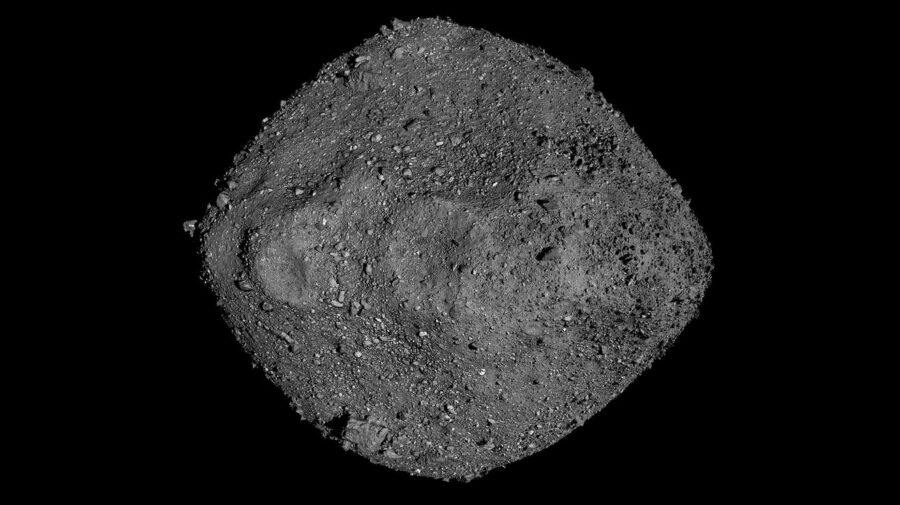Careful measurements using the OSIRIS-REX spacecraft have refined astronomers’ predictions for how likely it is that this potentially hazardous asteroid will strike Earth.
The near-Earth asteroid 101955 Bennu is best known as the curious, die-shaped world recently visited by NASA’s OSIRIS-REX spacecraft. But Bennu has another claim to fame: It’s one of the most hazardous asteroids in our planet’s neighborhood.
The 500-meter-wide object follows an orbit that keeps it close to Earth, even crossing our planet’s path as it travels around the Sun. The two orbits are tilted a mere 6° from each other’s planes. This setup made Bennu an excellent target for a sample-return mission, but it also makes the asteroid a thorn in planetary defense specialists’ sides.

Credit: NASA GSFC / University of Arizona
Astronomers discovered Bennu in 1999 and since then have collected hundreds of observations to determine the asteroid’s trajectory and the threat it poses. They can predict Bennu’s path in detail out to 2135, when it makes a close pass by Earth. But that pass could change everything. Depending on the exact location the asteroid traverses during its visit, Earth’s gravity could tug it such that on a future approach, Bennu will hit us instead of simply whizzing by.
These inimical points are called gravitational keyholes, and before OSIRIS-REX, there were 26 of them sitting like dynamical mines along Bennu’s 2135 path.
To assess just how worried we should be about Bennu, Davide Farnocchia (Jet Propulsion Laboratory) and colleagues used precise position and motion measurements gathered as part of OSIRIS-REX’s visit to Bennu to refine the asteroid’s trajectory. They considered a wide range of effects on the object’s motion, from the gravitational nudges of more than 300 other asteroids in the solar system to the small but persistent push created as Bennu’s sun-warmed surface reradiates its heat into the cold night of space. This radiative thrust, called the Yarkovsky effect, is so tiny that it’s equivalent to the weight of three grapes pushing on the surface, Farnocchia said during an August 11th press conference.
Thanks to OSIRIS-REX’s data, the scientists were able to rule out all but two of the keyholes, refining our knowledge of Bennu’s trajectory by a factor of 20. The new information puts the asteroid’s overall impact probability at less than 0.06% between now and the year 2300 — which, to be clear, is a small uptick from the previous estimate (which extended only to 2200). The importance lies in how many keyholes the team eliminated and, thus, the possible variations of our long-term fate.
The revised impact probability ties Bennu with 29075 (1950 DA), the most hazardous asteroid in the list from JPL’s Center for Near Earth Object Studies, as the team notes in their upcoming Icarus paper. Bennu’s single highest chance of hitting Earth comes in September 2182 (0.03%). Astronomers start worrying when the impact probability reaches 1%, said planetary defense officer Lindley Johnson (NASA) during the press conference.
Extrapolating from the asteroids detected so far, researchers think they’ve found nearly 80% of objects of Bennu’s size, Johnson said. NASA’s upcoming NEO Surveyor infrared space telescope aims to spot at least two-thirds of everything down to 140 meters, working toward Congress’s 2005 mandate to NASA to find more than 90% of all near-Earth objects larger than this size.
Bennu’s 2037 close approach will present observers with another opportunity to study the asteroid — albeit not one so prolonged or intimate as OSIRIS-REX did. Astronomers will use radar measurements taken during the flyby to test these latest calculations and make any needed refinements.
Watch a video summary of this result below.
Reference:
D. Farnocchia et al. “Ephemeris and hazard assessment for near-Earth asteroid (101955) Bennu based on OSIRIS-REx data.” Icarus. Posted online August 10, 2021.
 0
0









Comments
You must be logged in to post a comment.